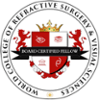Very high-frequency digital ultrasound
What is it?
A very high-frequency digital ultrasound (VHFU) is used to provide precise measurements of various aspects of the eye, including the surface of the eye (the cornea and epithelium) and the structures inside the eye (the iris, ciliary body, and crystalline lens).
How does it work?
A VHFU takes a series of 3D map-like pictures of the eye. For these images to be taken, the patient places their head on a chin-rest and the optometrist places a soft watertight goggle over the eye – this is then filled with a saline solution. The patient will be asked to open their eye and look at the focus point in the device.
Without touching the eye, the instrument scans the eye, taking a number of detailed cross-sectional images using sound waves. These images present the structure of the eye, including corneal thickness. VHFU with the ArcScan Insight 100 imaging takes approximately 3-5 minutes.
What are the Benefits?
VHFU is the most accurate way of measuring the cornea and most internal structures of the eye. Pre-operative VHFU can help to make earlier diagnoses of conditions that may affect the safety and outcomes of refractive surgery. For example, VHFU can detect micronic changes in the epithelium (surface layer of the cornea) that may indicate the early signs of keratoconus.
This is important as the presence of keratoconus requires moderations to be made to standard corneal refractive surgery or other treatment options (VHFU is also used in phakic IOL surgery, such as ICL sizing.). Furthermore, post-surgery VHFU allows for more accurate monitoring of the healing process, allowing for more improved decision making and management of further care.
VHFU is the most accurate way to measure various structures inside the eye that can affect the outcomes of surgery – in particular, the components of the eye behind the eye that can only be imaged using ultrasound.
The high-resolution imaging of specific landmarks inside the eye can help optometrists and surgeons to better predict the final position of phakic IOLs. This can help to significantly reduce the risk of complications in IOL procedures.


